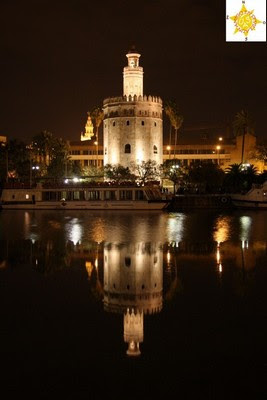If you are planning on visiting the city and do not
know what to do in Seville,
COUNT ON OUR HELP. We are at your entire disposal to accompany and assist you
in a personalized way, giving you full attention to make your stay in Seville
unique and unforgettable.
1. Seville Cathedral
The Cathedral of Saint Mary of the See, better known as Seville Cathedral, is a Roman Catholic cathedral in Seville (Andalusia, Spain).
It is the
largest Gothic cathedral and the third-largest
church in the world.
It was registered in 1987 by
UNESCO as a World Heritage Site, along with the
Giralda, Alcázar palace complex and the General Archive of the Indies.
After its completion in the
early 16th century, Seville Cathedral supplanted Hagia Sophia as the largest
cathedral in the world, a title the Byzantine church had held for nearly a
thousand years.
The cathedral is also the burial site of Christopher Columbus and of King Ferdinand III of Castile.
2. The Giralda
The Giralda is a former minaret that was
converted to a bell tower for the Cathedral of Seville in Seville. The tower is
97.5 m (101 m
with the Giraldillo) in height and it was one of the most important symbols in
the medieval city.
It was registered in 1987 by
UNESCO as a World Heritage Site, along with the Seville
Cathedral, Alcázar palace complex and the General Archive of the Indies.
3. The
Royal Alcázar of Seville
The Alcázar of Seville
is a royal palace in Seville, Spain, originally a Moorish fort.

It is the oldest royal palace
still in use in Europe, because the upper
levels of the Alcázar are still used by the royal family as the official
Seville residence.
The palace is one of the best remaining examples of mudéjar architecture.
Alcázar of Seville was registered in 1987 by UNESCO as a World Heritage Site, along with the Seville Cathedral, Giralda and the General Archive of the Indies.
4. Santa Cruz
Santa Cruz, is the primary tourist neighborhood of Seville, Spain, and the former Jewish quarter of the medieval city.
The neighborhood is the location of many of Seville's oldest churches and is home to the Cathedral of Seville, including the converted minaret of the old Moorish mosque Giralda.
Origin of the name: The present-day Plaza de Santa Cruz was once the site of the Iglesia de
Santa Cruz (Church of the Holy Cross), a parish church that gave its name to
the neighborhood.
The
neighborhood of Santa Cruz it may have been the birthplace of Don Juan
Tenorio.
The Plaza de los
Refinadores has a graceful sculpture of Don Juan.
5. Maria Luisa Park
The
Maria Luisa Park (Parque de María Luisa) is a public park that stretches
along the Guadalquivir River in Seville, Spain. It is
Seville's principal green area.
Most
of the grounds that were used for the park were formerly the gardens of the
Palace of San Telmo. They were donated to the city of Seville in 1893 by the Infanta
Maria Luisa Fernanda of Spain for use as a public park.
The park serves as a
botanical garden. Many plant species, native or exotic, are represented, along
with educational panels to inform the visitors to the park. Many birds make
their home in the park, which is known for its large population of doves.
One of the most important
monuments of the Maria Luisa Park is The
monument to Spanish post-romanticist writer of poetry and short stories Gustavo
Adolfo Bécquer.
This
scene is inspired by Becquer's poetry collection Rimas.
6.
Plaza de España
The Plaza
de España is a plaza located in the Maria Luisa Park, in Seville, Spain built in 1928 for the
Ibero-American Exposition of 1929. It is a landmark example of the Renaissance
Revival style in Spanish architecture.
The Plaza
de España, designed by Aníbal González, was a principal building
built on the Maria Luisa Park's edge to showcase Spain's industry and
technology exhibits. González combined a mix of 1920s Art Deco and 'mock
Mudejar', and Neo-Mudéjar styles.
The Plaza
de España complex is a huge half-circle with buildings continually running
around the edge accessible over the moat by numerous beautiful bridges. In the
centre is a large fountain.
By
the walls of the Plaza are many tiled alcoves, each representing a
different province of Spain.
7.
Torre del Oro
The Torre del Oro ("Gold Tower") is a dodecagonal military watchtower in Seville, southern Spain, built by the Almohad dynasty in order to control access to Seville via the Guadalquivir river.
The Torre del Oro ("Gold Tower") is a dodecagonal military watchtower in Seville, southern Spain, built by the Almohad dynasty in order to control access to Seville via the Guadalquivir river.
The
tower is divided into three levels, with the third and uppermost being circular
in shape and added in 1769.
Today
the tower, having been restored, is a naval museum, containing
engravings, letters, models, instruments, and historic documents. The museum
outlines the naval history of Seville and the importance of its river.
So far we have shown
the most famous and representative places and monuments of the city of Seville. Then we will show pictures of some
of the many lesser-known sights of the city of Seville, and with our
personalized advice and support tourism may know.
For any
information or to contact us please visit our website: www.unamigoensevilla.com














































